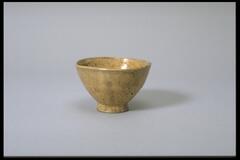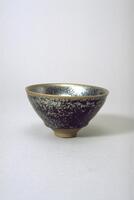11 Items in this Learning Collection
Collection Object
Collection Object
Collection Object
Collection Object
Collection Object
Collection Object
Collection Object
Collection Object
Copyright
All Rights Reserved
()
Bowl
Accession Number
1973/2.19
Title
Bowl
Artist(s)
Chinese
Artist Nationality
Chinese (culture or style)
Object Creation Date
960-1279
Medium & Support
porcelain with glaze
Dimensions
2 11/16 in x 7 in x 7 in (6.8 cm x 17.8 cm x 17.8 cm)
Credit Line
Gift of Mrs. Caroline I. Plumer for the James Marshall Plumer Collection
Subject matter
This is a Qingbai (青白, literally “bluish white”) teabowl of the Song dynasty (960-1279). The unglazed rim would have been finished with a copper or silver metal band.
From the eighth century on, tea drinking was firmly established as an important Chinese social custom. The tea was taken in the form of a powder that was whisked into a frothy brew with hot water in elegant conical ceramic bowls. Initially, white wares from Yue, Xing, and Ding kilns were favored, but later black tea bowls from Jian became the color of choice.
Qingbai wares, which consisted primarily of tea bowls, were produced in southern China during the Song dynasty (960-1279) at Jingdezhen, Jiangxi in imitation of northern Ding porcelains. A reduction atmosphere in the Jingdezhen kilns and a high kaolin and low iron content in the clay result in the pale blue cast to Qingbai wares.
Song society, lead by cultured emperors like Huizong (r. 1101-26) and Gaozong (r.1127-63), did not seek power and empire like the previous Tang dynasty, but instead sought learning and contemplation surrounded by refined and elegant daily objects. The pottery industry responded by producing immaculate white wares that could replace silver as luxury tableware. By the eleventh century, Ding had become firmly established as the great white ware of the north, just as the great white ware of the south, qingbai ware was started being produced at the kilns of Jingdezhen in Jiangxi province. Chinese connoisseurs of the time praised the color and feel of qingbai tea bowls as being like “icy jade” and the ware went on to make Jingdezhen the porcelain capital of the world from the tenth to fourteenth centuries.
Physical Description
This thin porcelain conical bowl with direct rim on a footring has an interior with incised and combed cloud decoration. It is covered in a white glaze with bluish tinge and has an unglazed rim.
Primary Object Classification
Ceramic
Primary Object Type
bowl
Collection Area
Asian
Rights
If you are interested in using an image for a publication, please visit http://umma.umich.edu/request-image for more information and to fill out the online Image Rights and Reproductions Request Form. Keywords
Qingbai
bowl
bowls (vessels)
ceramic (material)
clouds
porcelain (material)
porcelain (visual works)
1973/2.19
Title
Bowl
Artist(s)
Chinese
Artist Nationality
Chinese (culture or style)
Object Creation Date
960-1279
Medium & Support
porcelain with glaze
Dimensions
2 11/16 in x 7 in x 7 in (6.8 cm x 17.8 cm x 17.8 cm)
Credit Line
Gift of Mrs. Caroline I. Plumer for the James Marshall Plumer Collection
Subject matter
This is a Qingbai (青白, literally “bluish white”) teabowl of the Song dynasty (960-1279). The unglazed rim would have been finished with a copper or silver metal band.
From the eighth century on, tea drinking was firmly established as an important Chinese social custom. The tea was taken in the form of a powder that was whisked into a frothy brew with hot water in elegant conical ceramic bowls. Initially, white wares from Yue, Xing, and Ding kilns were favored, but later black tea bowls from Jian became the color of choice.
Qingbai wares, which consisted primarily of tea bowls, were produced in southern China during the Song dynasty (960-1279) at Jingdezhen, Jiangxi in imitation of northern Ding porcelains. A reduction atmosphere in the Jingdezhen kilns and a high kaolin and low iron content in the clay result in the pale blue cast to Qingbai wares.
Song society, lead by cultured emperors like Huizong (r. 1101-26) and Gaozong (r.1127-63), did not seek power and empire like the previous Tang dynasty, but instead sought learning and contemplation surrounded by refined and elegant daily objects. The pottery industry responded by producing immaculate white wares that could replace silver as luxury tableware. By the eleventh century, Ding had become firmly established as the great white ware of the north, just as the great white ware of the south, qingbai ware was started being produced at the kilns of Jingdezhen in Jiangxi province. Chinese connoisseurs of the time praised the color and feel of qingbai tea bowls as being like “icy jade” and the ware went on to make Jingdezhen the porcelain capital of the world from the tenth to fourteenth centuries.
Physical Description
This thin porcelain conical bowl with direct rim on a footring has an interior with incised and combed cloud decoration. It is covered in a white glaze with bluish tinge and has an unglazed rim.
Primary Object Classification
Ceramic
Primary Object Type
bowl
Collection Area
Asian
Rights
If you are interested in using an image for a publication, please visit http://umma.umich.edu/request-image for more information and to fill out the online Image Rights and Reproductions Request Form. Keywords
Qingbai
bowl
bowls (vessels)
ceramic (material)
clouds
porcelain (material)
porcelain (visual works)
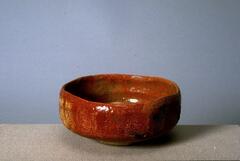

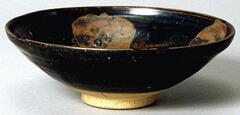
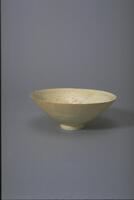
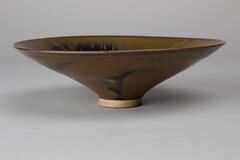
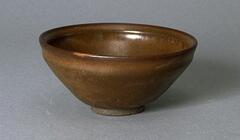

![It has a flared mouth. The side is tapering gently down to the base. It was brushed with white slip interior and outerior sides.<br />
<br />
Bowls of this kind were commonly used as burial accessories in the 15th century Joseon; many have been excavated. This bowl has been rapidly spun and brush-painted with white slip on its inner and outer surfaces. The large amount of sand mixed with the clay has produced a rough texture. Traces of clay supports remain on both the inner base and the rim of foot, indicating that this bowl was stacked among other bowls while separated by clay spurs during firing. The glaze was fused well, producing a glossy surface.<br />
[Korean Collection, University of Michigan Museum of Art (2014) p.155] It has a flared mouth. The side is tapering gently down to the base. It was brushed with white slip interior and outerior sides.<br />
<br />
Bowls of this kind were commonly used as burial accessories in the 15th century Joseon; many have been excavated. This bowl has been rapidly spun and brush-painted with white slip on its inner and outer surfaces. The large amount of sand mixed with the clay has produced a rough texture. Traces of clay supports remain on both the inner base and the rim of foot, indicating that this bowl was stacked among other bowls while separated by clay spurs during firing. The glaze was fused well, producing a glossy surface.<br />
[Korean Collection, University of Michigan Museum of Art (2014) p.155]](/media/W1siZiIsIjIwMjIvMDUvMjUvN2wwZnA4dXE4NV9kZWZhdWx0LmpwZyJdLFsicCIsInRodW1iIiwiMjQweDIwMCJdXQ?sha=8feb467e9a78db04)
![It has large-mouth and the wall slants toward the bottom in an almost straight line. It was deformed during firing.<br />
<br />
The inner and outer surfaces of this bowl are brushed with white slip. Traces of refractory spurs remain in five places on the inner base and the foot. The foot is glazed on the rim as well. This is a low-grade object with many iron-brown spots on both its inner and outer surfaces. A note from collector is adhered to the reverse side of the bowl, and it reads, “19629, corée, Hakéme,” “朝鮮刷毛目, 三百年.”<br />
[Korean Collection, University of Michigan Museum of Art (2014) p.156] It has large-mouth and the wall slants toward the bottom in an almost straight line. It was deformed during firing.<br />
<br />
The inner and outer surfaces of this bowl are brushed with white slip. Traces of refractory spurs remain in five places on the inner base and the foot. The foot is glazed on the rim as well. This is a low-grade object with many iron-brown spots on both its inner and outer surfaces. A note from collector is adhered to the reverse side of the bowl, and it reads, “19629, corée, Hakéme,” “朝鮮刷毛目, 三百年.”<br />
[Korean Collection, University of Michigan Museum of Art (2014) p.156]](/media/W1siZiIsIjIwMjIvMDUvMjUvOGwxcWg2N25pdF9kZWZhdWx0LmpwZyJdLFsicCIsInRodW1iIiwiMjQweDIwMCJdXQ?sha=35d40b809bdc1c1f)
